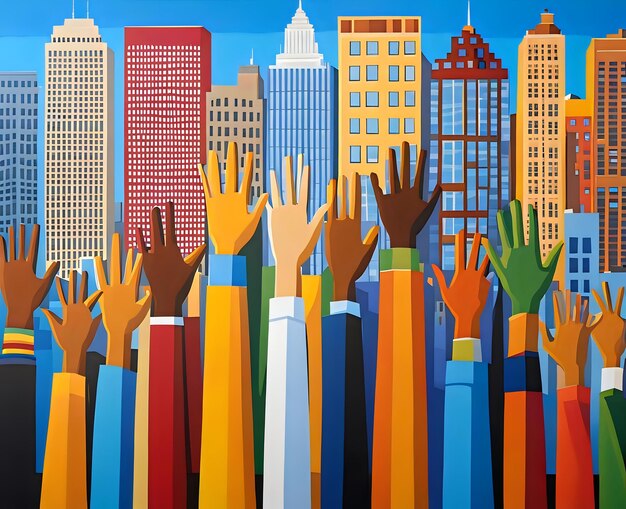15% Federal Funding Increase for Social Justice: 2025 Debate Impacts

A proposed 15% increase in federal funding for social justice initiatives in 2025 is poised to significantly reshape national debate outcomes by intensifying discussions on allocation, efficacy, government oversight, and the very definition of social justice, leading to potentially polarized yet critical policy developments.
In an evolving political landscape, the prospect of a 15% increase in federal funding for social justice initiatives in 2025 is not merely a budgetary adjustment; it’s a potential catalyst for profound shifts in public discourse. This significant financial commitment suggests a re-prioritization of societal values, aiming to address longstanding inequities that pervade various sectors of American life. Such a substantial investment opens myriad discussions, forcing stakeholders across the political spectrum to re-evaluate their positions on government intervention, social welfare, and the very fabric of justice itself.
Understanding the Scope of the Proposed Funding Increase
The debate surrounding federal funding for social justice initiatives is complex, often touching upon deeply held ideological beliefs. A proposed 15% increase in 2025 would represent a notable commitment, potentially allocating billions more towards programs aimed at addressing systemic inequalities in areas such as education, healthcare, criminal justice, and economic opportunity. This isn’t just about raw numbers; it’s about the strategic intent behind the investment and the diverse interpretations of “social justice” itself.
Defining Social Justice Initiatives
Social justice initiatives are broad and encompass a wide range of programs designed to promote fairness and equity. These can include:
- Educational Equity Programs: Funding for under-resourced schools, scholarships for marginalized students, and initiatives to reduce achievement gaps.
- Healthcare Access and Disparities: Programs to expand access to affordable healthcare, address health inequities in minority communities, and support mental health services.
- Criminal Justice Reform: Investments in policing reform, re-entry programs for former inmates, and efforts to reduce mass incarceration.
- Economic Opportunity and Empowerment: Small business grants for minority-owned enterprises, job training programs, and affordable housing initiatives.
The 15% increase would likely distribute these funds across existing and potentially new programs, sparking intense scrutiny over which areas receive the most attention and why. The debate isn’t just about the funding itself, but how it aligns with differing visions of a just society.
The increased allocation would inevitably create pressure to demonstrate tangible results and accountability. Historically, federal programs, particularly those addressing social issues, have faced challenges in proving direct causation for improvements due to the multifaceted nature of societal problems. This leads to a critical layer of debate: how will success be measured, and who will define it? Expect robust discussions where data-driven efficacy becomes a central contested point, influencing future funding decisions and political narratives.
Economic Implications and Allocation Challenges
The economic ripple effects of a 15% increase in federal funding for social justice initiatives are multifaceted and will undoubtedly fuel significant debate in 2025. This influx of capital, estimated to be in the billions, can stimulate local economies, create jobs, and potentially alleviate financial burdens on vulnerable populations. However, the allocation of these funds presents a crucial challenge, as differing priorities and methodologies for distribution will inevitably emerge.
Increased federal spending may lead to debates about potential inflationary pressures, even as proponents argue that targeted investments in underserved communities can improve long-term economic stability and reduce societal costs associated with inequality. The funding could be channeled through existing federal agencies, state and local governments, or non-profit organizations, each pathway bringing its own set of administrative complexities and oversight requirements. This will open discussions on which entities are best equipped to manage these funds effectively and transparently.
Federal vs. Local Control: Who Decides?
A significant point of contention will likely revolve around the balance of power in fund distribution:
- Centralized Federal Control: Proponents argue this ensures national standards and equitable distribution across states, regardless of local political leanings.
- Decentralized Local Control: Advocates suggest that local communities are better positioned to identify and address their unique social justice needs, tailoring programs more effectively.
The debate will weigh the benefits of national coherence against the advantages of local responsiveness. Crafting a funding mechanism that satisfies both viewpoints will be a high-stakes legislative challenge.
Furthermore, economic arguments will pivot around the long-term sustainability of these initiatives. Critics might question whether such increases are sustainable without significant tax increases or reallocation from other vital sectors. Conversely, supporters will highlight the societal return on investment, positing that reducing inequality leads to a more productive workforce, less strain on public services, and overall greater economic prosperity. This will require rigorous economic modeling and often, a willingness to project benefits over multi-year or even multi-decade horizons, a notoriously difficult task for political consensus.
Political Polarization and Rhetorical Battlegrounds
The proposed 15% increase in federal funding for social justice initiatives in 2025 is poised to intensify existing political polarization, transforming it into a rhetorical battleground where fundamental disagreements about government’s role, individual liberty, and collective responsibility will clash. This substantial financial commitment provides tangible stakes, giving both supporters and opponents concrete policy to champion or criticize. The debates are unlikely to remain confined to abstract principles; rather, they will distill into arguments about specific programs, their beneficiaries, and their perceived impact on American society.
Expect to see stark ideological divides between those who view social justice as a moral imperative requiring governmental intervention and those who believe such intervention oversteps bounds, fosters dependency, or distorts market forces. The language used by politicians and media outlets will likely become highly charged, framing the funding increase as either a crucial step towards a more equitable nation or an egregious example of government overreach.
Framing the Narrative: Competing Ideologies
The framing of this funding will be pivotal in shaping public opinion:
- Progressive Framing: Emphasizes systemic injustices, historical wrongs, and the government’s responsibility to correct imbalances and promote equity for all citizens.
- Conservative Framing: Often highlights concerns about individual responsibility, free markets, limited government, and the potential for “wokeness” or wasteful spending.
These competing narratives will be deployed in political campaigns, media appearances, and public forums, aiming to sway voters and build coalitions for or against the funding increase.
The intensity of these debates will also influence primary and general elections in 2025 and beyond. Candidates will be pressured to clearly articulate their stance on social justice funding, making it a litmus test for voter alignment. Swing voters, in particular, will be subjected to extensive messaging designed to evoke emotional responses and rationalize policy positions. This dynamic will not only affect legislative outcomes but also the broader political culture, potentially deepening partisan divides and making bipartisan cooperation even more challenging.

The Role of Efficacy and Accountability in Public Discourse
With any significant federal funding allocation, the questions of efficacy and accountability are paramount, and the 15% increase for social justice initiatives will be no exception. As taxpayers’ money is committed, there will be intense public and political pressure to demonstrate that these programs are achieving their stated goals and delivering tangible, positive outcomes. The debate outcomes in 2025 will heavily hinge on the perceived success or failure of these initiatives, rather than just their intentions.
Critics will rigorously scrutinize spending, demanding transparent reporting and measurable impact. This will necessitate the development of robust metrics and evaluation frameworks, which themselves can become points of contention. What constitutes “success” in social justice, and how can it be quantitatively measured? These are complex questions that lack universally accepted answers, opening avenues for differing interpretations and political maneuvering.
Measuring Impact: Challenges and Criteria
Defining and measuring the impact of social justice initiatives is inherently difficult due to their multi-faceted nature:
- Quantitative Metrics: Such as reductions in poverty rates, improvements in educational attainment, or decreases in incarceration rates.
- Qualitative Assessments: Including community feedback, improvements in quality of life, and changes in systemic biases.
The debate will be about balancing these quantitative and qualitative measures, ensuring that the former doesn’t overshadow the latter, and vice-versa, while also guarding against data manipulation or cherry-picking to fit political agendas.
Moreover, accountability extends beyond just financial auditing. It involves ensuring that the programs are implemented ethically, without discriminatory practices, and that they genuinely reach the intended beneficiaries. Any instances of mismanagement, fraud, or perceived ineffectiveness will be amplified by opponents of the funding, potentially undermining public trust and future support for social justice initiatives. Therefore, stringent oversight mechanisms and clear lines of responsibility will be crucial for maintaining the integrity and public acceptance of these programs.
Media Representation and Public Perception
The media’s portrayal of the proposed 15% increase in federal funding for social justice initiatives will significantly influence public perception and, consequently, the trajectory of related debates in 2025. News outlets, social media platforms, and opinion shapers hold immense power in framing narratives, highlighting specific aspects of the funding, and shaping how the public interprets its purpose and potential impact. This makes media representation a crucial battleground for advocates and opponents alike.
Journalists have the responsibility to report factually, but editorial choices, emphasis, and the selection of sources can subtly, or overtly, sway public opinion. Sensationalized headlines, anecdotal evidence, or a focus on extreme viewpoints might overshadow more nuanced realities, polarizing the discussion further. Conversely, in-depth investigative reporting could illuminate the genuine needs these funds aim to address and the potential for positive change.
Shaping Narratives: Biases and Empathy
Media coverage can manifest in various ways, influencing how the public perceives these initiatives:
- Focus on Success Stories: Highlighting individual or community transformations due to funding, fostering empathy and support.
- Emphasis on Controversies: Concentrating on misuse of funds, perceived failures, or controversial aspects of specific programs, fueling skepticism and opposition.
The balance between these narratives will be critical in deciding whether the public views the funding as a necessary investment or a questionable expenditure.
Furthermore, social media serves as an echo chamber, amplifying existing biases and allowing for rapid dissemination of information—and misinformation. Hashtag campaigns, viral videos, and influencer opinions can quickly shape public discourse, often bypassing traditional editorial gatekeepers. For social justice advocates, this presents an opportunity to mobilize support and share direct testimonies. For opponents, it offers a platform to organize dissent and raise concerns about the funding’s implications. The interplay between traditional media and social media will be a powerful force in molding the public’s understanding and acceptance of the funding increase.
Anticipated Legislative Processes and Future Outlook
The journey of the proposed 15% increase in federal funding for social justice initiatives through the legislative process in 2025 will be a complex and often contentious one, profoundly influencing the ultimate debate outcomes. Even with an initial proposal, the actual implementation requires congressional approval, potentially involving appropriations committees, floor debates, and intense negotiations between different political factions. The legislative outlook will be shaped by the political composition of Congress, the priorities of the executive branch, and the prevailing public sentiment orchestrated through the media.
Expect numerous amendments, riders, and attempts to attach conditions to the funding, reflecting diverse political agendas. The final form of the legislation might differ significantly from the initial proposal, as compromises are sought to secure sufficient votes. This pragmatic reality means that even strong proponents of social justice may have to accept concessions, while opponents might aim to dilute the impact or redirect funds.
Legislative Hurdles and Opportunities
Key legislative aspects that will influence the funding’s fate include:
- Budget Reconciliation: A powerful tool allowing certain legislation to pass with a simple majority, potentially bypassing filibuster attempts in the Senate.
- Bipartisan Negotiations: The necessity of finding common ground to secure broader support, which may lead to modifications or scaling back of ambitions.
The strategic use of legislative procedures, combined with the art of political persuasion, will determine the program’s scope and longevity.
Looking beyond 2025, the trajectory of these initiatives will also depend on their perceived success and the ongoing political climate. If programs funded by this increase demonstrate clear, positive impacts, it could lay the groundwork for sustained or even increased funding in subsequent years. Conversely, if effectiveness is questioned or political tides shift, the funding could become a target for immediate cuts. This long-term outlook underscores the importance of not just securing the initial increase, but also building robust mechanisms for evaluation, transparency, and public communication to ensure enduring support. Therefore, the debates of 2025 will not solely decide the fate of this one-time increase, but potentially set the stage for the future of federal engagement in social justice.

| Key Point | Brief Description |
|---|---|
| 📈 Economic Impact | Increased federal funding could stimulate local economies, but will spark debates on inflation and allocation methods. |
| polarized Political Debates | The funding increase will intensify ideological clashes over government’s role and individual liberty. |
| 📊 Efficacy & Accountability | Demands for measurable results and transparent spending will be central, posing challenges for defining “success.” |
| 🏛️ Legislative Challenges | Congressional approval, amendments, and bipartisan negotiations will shape the final form and scope of funding. |
Frequently Asked Questions About Social Justice Funding
While precise allocations will be debated, historical trends suggest significant portions could go towards educational equity, healthcare access, criminal justice reform, and economic empowerment programs. The final distribution will depend on legislative priorities and the specific definitions of “social justice” adopted during congressional deliberations in 2025.
A federal increase could either supplement or potentially influence the direction of state and local efforts. Some argue it could incentivize new programs or expand existing ones, while others fear it might reduce local funding accountability if states become overly reliant on federal dollars. The outcome will likely vary by state and specific program type.
Opponents often cite concerns about government overreach, potential for wasteful spending, inflationary pressures, and the belief that such issues are better addressed by local communities, private charities, or individual responsibility rather than federal intervention. There are also debates around the effectiveness and precise definition of “social justice.”
Measuring efficacy will be a key debate point. It will likely involve a combination of quantitative metrics (e.g., poverty rates, graduation rates, incarceration statistics) and qualitative assessments (e.g., community well-being, anecdotal evidence). Robust accountability mechanisms and transparent reporting will be crucial to satisfy public and political scrutiny.
Initially, a significant funding increase is likely to exacerbate political polarization as different factions solidify their positions on its necessity and implementation. However, if programs demonstrate clear, bipartisanly recognized successes over time, it could potentially build a foundation for greater consensus on specific social justice measures in the long run.
Conclusion
The proposed 15% increase in federal funding for social justice initiatives in 2025 stands as a pivotal moment, poised to profoundly reshape national debate outcomes. This significant financial commitment will not only fuel intense discussions on economic implications, allocation methodologies, and political polarization, but also elevate the critical importance of program efficacy and accountability. The media’s role in shaping public perception will be undeniable, as will the complex legislative processes required for implementation. Ultimately, this investment will force a re-evaluation of societal priorities, demanding robust discourse, transparent oversight, and a collective commitment to defining and achieving a more equitable future for all citizens of the US. The outcomes of these 2025 debates will not merely dictate federal spending, but fundamentally influence the trajectory of social justice movements and policy for years to come.





